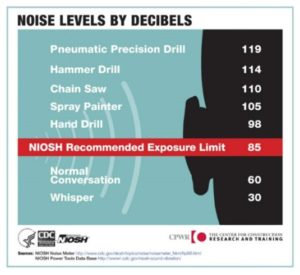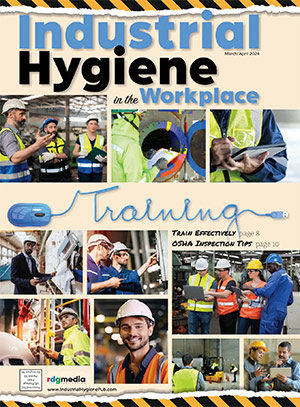Now Hear This: Right Steps for Hearing Conservation Training
Dr. Vickie Tuten and Dr. Kathy Gates, Contributors
Hear, hear! Industrial hygienists serve key roles in providing education and training, one of the essential elements of a Hearing Conservation Program (HCP). Consistent delivery of effective education can have a positive impact on influencing workers to voluntarily adopt behaviors that preserve their sense of hearing.
The Occupational Noise Exposure mandate (OSHA’s 29 CFR 1910.95) requires employees exposed to 85dBA TWA be enrolled in the HCP. Employers are required to ensure employees participate in hearing conservation training for the duration of their employment. This should begin with initial orientation training, followed by annual reinforcement.
We will cover the mandates of 29 CFR 1910.95 and specifically highlight the who, when, what and how.
Who: All employees exposed to 85 dBA TWA, for even one day, need to be enrolled in the HCP. 85 dBA TWA is referred to as the action level (AL) under OSHA. The program must have, at a minimum, annual testing, annual training and available hearing protection to enrolled employees. When employees reach the Permissible Exposure Limit (PEL) of 90 dBA TWA, hearing protection is mandated. Annual education and training remain a constant throughout, once the AL is reached.
When: HCP training must be completed annually, and employers must ensure employee participation. The education and training element allows flexibility for the employer to provide the training at different times throughout the year, by any HCP team member. There is not a requirement to discuss all mandated education and training topics in a single event; however, the mandatory topics need to be covered and employee attendance rosters maintained.
What: 29 CFR 1910.95 includes specific guidance as to what topic areas must be covered annually. The required topics can be broken into three “buckets” of information to include the following:
- The effects of noise on hearing
- The purpose of hearing protectors; the advantages, disadvantages and attenuation of various types; and instructions on selection, fitting, use and care
- The purpose of audiometric testing and an explanation of the test procedures
Some industries are covered by regulations outside of the general industry standard covered by 29 CFR 1910.95. If your industry is covered by another federal regulation, please consult those regulations for specifics related to this HCP elements. Several links are listed below:
MSHA’s 30 CFR Part 62, 62.180 (VOLUME III – 30 CFR PARTS 40 THROUGH 50 AND PARTS 62 and 100 | Mine Safety and Health Administration (MSHA)
FRA’s 49 CFR 227.119 (49 CFR 227.119 – Training program. (govregs.com)
How: As an industrial hygienist, you are well-positioned to provide both formal training, as well as informal or impromptu education, when conducting area monitoring or dosimetry. Formal training should always be documented and records maintained in event of an audit. Informal or impromptu education serves as great reinforcement to remind workers of the importance of adopting good hearing conservation practices.
The training element is flexible and allows for creativity to be incorporated into the process. When you break the topics into the three buckets of information, the primary focus of the industrial hygienist would be to provide training on the “effects of noise on hearing” and “all things hearing protection.”
The third required topic, “purpose of audiometric testing and explanation of test procedures,” should be provided by the hearing technician at the time of the hearing test.
The topic “effects of noise on hearing” can be delivered at any time. This could be covered during a formal training session or shared with workers while visiting individual worksites. The informal education session is an excellent opportunity to discuss the noise hazards being heard in participants’ workplaces; how unprotected exposures to this noise hazard may result in a permanent injury/illness; and how properly worn hearing protection can mitigate the risk of a permanent hearing loss.
Effective messaging will positively influence behavioral change. Showing an image of a healthy cochlea and one damaged from noise will make the injury something the employee can visualize. Education and training on the effects of hazardous noise exposure should include both auditory effects (e.g., noise-induced hearing loss, tinnitus, hyperacusis) and non-auditory effects (e.g., hypertension, stress, depression, etc.). Visual aids can be particularly helpful in helping convey the damaging effects of unprotected noise exposure.
Covering “all things hearing protection” is a critical part of the orientation and annual education provided to employees. Industrial hygienists are well-suited to take on a major role in educating employees about hearing protection. This might start with their role in noise measurements and noise control; determining which employees may be enrolled; what their exposures are; and how much attenuation is required to adequately protect the employee.
An emerging best practice is Hearing Protection Device (HPD) Fit Testing and a role well-suited to the industrial hygienist. HPD Fit Testing, regardless of method utilized, results in a Personal Attenuation Rating (PAR) for the employee obtained while wearing the hearing protection device with which they have been fit. The HPD Fit Test can reinforce training by providing immediate feedback to the employee on how well they inserted their hearing protection. This PAR eliminates any guesswork on attenuation achieved with the hearing protection worn by that employee. The report can then be maintained in the employee’s records.
Repeated non-compliance with the mandatory wear of hearing protection should be documented and reasonable disciplinary action taken as a last resort, in keeping with employer’s policies. There is real value, however, in gaining voluntary compliance. Effective messaging can convince the employee that the benefits outweigh the inconvenience of hearing protection. That voluntary compliance is more likely to ensure the use of hearing protection continues with off-duty noise exposures, as well.
 An employee needs to understand that unprotected exposures to hazardous noise, regardless of where that exposure occurs, can result in a life-altering, permanent hearing loss with many associated negative auditory and non-auditory effects. They also need to understand that when they cannot move away from the hazardous noise source, or turn down the volume, the only course of action that can change the outcome is the proper use of PPE.
An employee needs to understand that unprotected exposures to hazardous noise, regardless of where that exposure occurs, can result in a life-altering, permanent hearing loss with many associated negative auditory and non-auditory effects. They also need to understand that when they cannot move away from the hazardous noise source, or turn down the volume, the only course of action that can change the outcome is the proper use of PPE.
There are several hearing conservation resources available to help inform and educate workers about hazardous noise and the importance of wearing hearing protection. Infographics are another great way to explain hazardous noise levels.
Below are some links that provide useful information about hazardous noise and hearing protection. Check out these websites to help you prepare and package your messages about hazardous noise and use of hearing protection. Your one-on-one discussions with workers while visiting worksites can have a positive impact on the prevention of noise-induced hearing loss. As an industrial hygienist, you definitely have a role in saving hearing, one ear at a time. IHW
About the Authors
Dr. Vickie Tuten and Dr. Kathy Gates are both AuD audiologists. Dr. Gates works for the DOD HCE, as a contractor, zCore Business Solutions, Inc. Dr. Tuten is an independent contractor with Occupational Marketing, Inc., where she teaches CAOHC courses. Both were also military audiologists.
Additional Resources:
Noise and Hearing Loss Prevention | NIOSH | CDC
Listen Up! Protect Your Hearing (infographic) | NIDCD (nih.gov)
Share on Socials!
Working In Permit-Required Confined Spaces
Lone Worker Safety and the Rise of eCommerce
Communication is Key to Safe Confined Space Entry
Leaders in Industrial Hygiene
Council for Accreditation in Occupational Hearing Conservation (CAOHC)
Subscribe!
Sign up to receive our industry publications for FREE!









